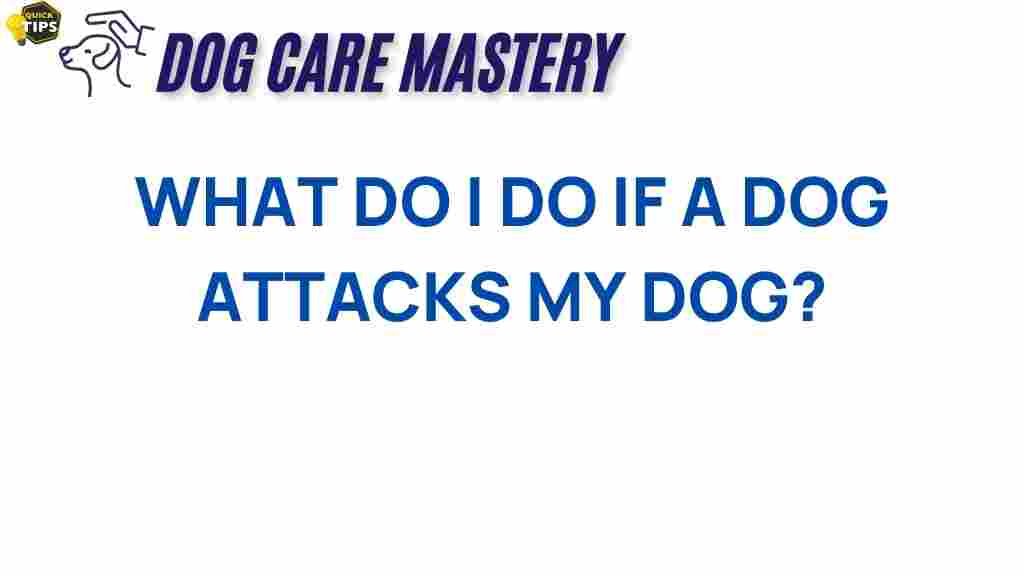Experiencing a dog attack can be an overwhelming and distressing situation for any pet owner. If your dog has been attacked, it’s essential to know the appropriate steps to take in order to ensure the safety and well-being of both your dog and yourself. This article will provide a comprehensive guide on what to do if a dog attacks your dog, offering practical advice and support in the aftermath of such an incident.
Understanding the Immediate Aftermath
When a dog attack occurs, the first few moments are crucial. The actions you take immediately following the incident can significantly influence the outcome for your pet. Here’s a step-by-step guide on how to handle the scenario.
Step 1: Assess the Situation
As soon as a dog attack happens, it’s vital to remain as calm as possible. Panic can exacerbate the situation. Follow these steps:
- **Check Your Dog’s Condition:** Look for visible signs of injury such as bleeding, wounds, or signs of distress.
- **Evaluate the Other Dog:** If safe to do so, assess the other dog’s behavior. Is it aggressive? Is it still a threat?
- **Avoid Confrontation:** Do not approach the other dog unless you are sure it is safe. An aggressive dog may pose a risk to you as well.
Step 2: Separate the Dogs Safely
If the other dog is still aggressive, ensure your dog is removed from the situation as quickly and safely as possible. Here are some strategies:
- **Call Your Dog:** Use a calm and reassuring voice to call your dog towards you.
- **Use a Barrier:** If you have a leash or can use an object to create distance, do so without putting yourself in harm’s way.
- **Avoid Direct Confrontation:** Do not attempt to physically separate the dogs unless absolutely necessary, as this could lead to injury.
Step 3: Check for Injuries
Once your dog is safe, it’s time to assess any injuries:
- **Look for Wounds:** Check for cuts, bites, or other injuries.
- **Monitor Behavior:** Look for signs of pain such as whimpering, reluctance to move, or unusual aggression.
- **Seek Veterinary Care:** Regardless of visible injuries, it’s recommended to have a veterinarian evaluate your dog to address any internal injuries or infections.
Step 4: Document the Incident
Documentation can be critical following a dog attack. Here’s what to do:
- **Take Photos:** Capture images of your dog’s injuries and the location of the incident.
- **Gather Witness Information:** If there were any witnesses, collect their contact information.
- **Record Details:** Write down all relevant details of the attack including date, time, location, and the other dog’s owner, if applicable.
Step 5: Report the Incident
Depending on the severity of the attack, you may need to report the incident:
- **Notify Local Authorities:** If the attack was severe or if the other dog is a known aggressive breed, contact animal control.
- **Inform Your Veterinarian:** They may need to report the attack if your dog’s injuries meet certain criteria.
- **Consider Legal Action:** If your dog was seriously injured, you may want to consult with a legal professional about your options.
Troubleshooting Tips
In the aftermath of a dog attack, you may face various challenges. Here are some troubleshooting tips that may help:
Addressing Behavioral Changes
After a traumatic event, dogs can exhibit behavioral changes. Here’s how to cope:
- **Patience:** Allow your dog time to adjust and heal. Behavioral changes may take time to resolve.
- **Professional Help:** Consider hiring a dog trainer or behaviorist if your dog shows signs of aggression or fear.
- **Positive Reinforcement:** Use treats and praise to encourage desired behaviors and build your dog’s confidence.
Financial Considerations
Dog attacks can lead to unexpected medical bills. Here’s how to manage:
- **Insurance Claims:** If you have pet insurance, check if the incident is covered.
- **Keep Records:** Maintain all documentation related to veterinary visits and expenses for potential claims.
- **Discuss with the Other Party:** If the other dog’s owner is responsible, you may want to discuss liability and potential reimbursement for vet bills.
Legal Considerations
Understanding your rights can be essential, especially if you face legal repercussions.
- **Dog Bite Laws:** Familiarize yourself with local dog bite laws, as they vary by location.
- **Consult Legal Counsel:** If you’re unsure of your rights or how to proceed, a consultation with an attorney who specializes in animal law can be beneficial.
Preventing Future Incidents
Once the immediate situation is handled, consider how to prevent future dog attacks:
- **Training:** Invest in training for your dog to improve socialization and obedience skills.
- **Leash Control:** Always keep your dog on a leash in public spaces.
- **Avoid Aggressive Dogs:** Be mindful of your surroundings and avoid areas where aggressive dogs are known to roam.
Conclusion
Dealing with a dog attack can be an incredibly stressful experience, but knowing the right steps to take can help you navigate this challenging situation. From assessing the immediate aftermath to addressing behavioral changes and financial considerations, each step is crucial in ensuring the well-being of your dog and protecting your rights as a pet owner. Always prioritize safety, seek veterinary care when needed, and do not hesitate to seek professional advice for behavioral issues or legal concerns. For more information on dog care and safety, you can check out this resource on dog safety tips and visit local animal control websites for assistance in your area. Remember, being prepared and informed can make all the difference in navigating the aftermath of a dog attack.
This article is in the category Safety and created by dogcaremastery Team
